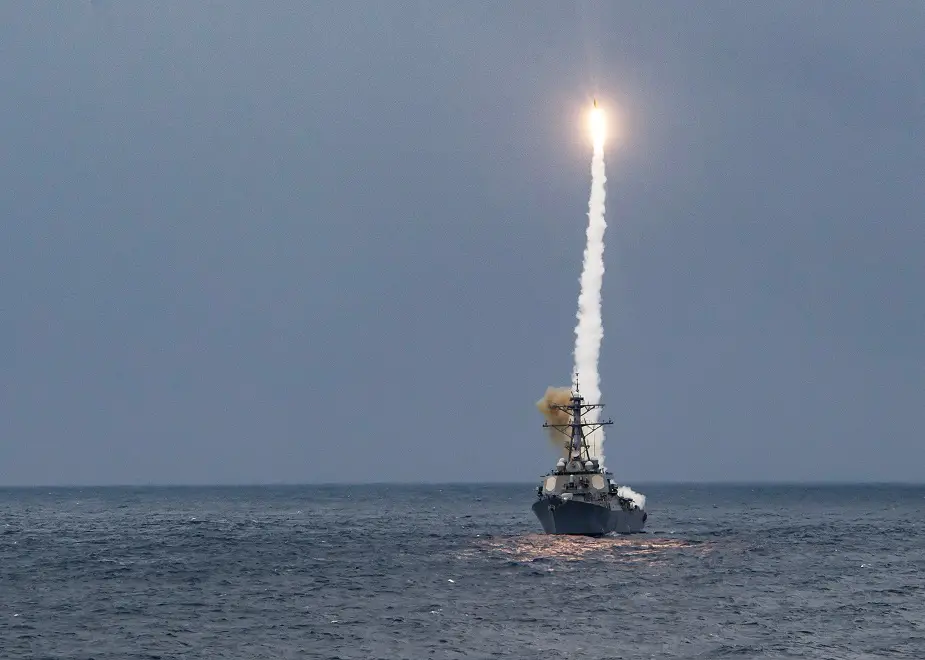Breaking news
US Navy CSG in Intense Live Fire Exercise to Increase Fleet Lethality and Tactical Proficiency.
Warships from the USS Abraham Lincoln (CVN 72) Carrier Strike Group (CSG), along with other Norfolk-based cruiser-destroyer (CRUDES) units, participated Nov. 5 in a Live Fire With A Purpose (LFWAP) missile exercise (MSLEX) off the East Coast of the U.S. demonstrating enhanced lethality, capability and readiness.
 ATLANTIC OCEAN (Nov. 5, 2018) The Arleigh Burke-class guided-missile destroyer USS McFaul (DDG 74) launches a Standard Missile 2 during a Live Fire With a Purpose (LFWAP) event. The LFWAP program is a reinvigorated missile exercise program designed to increase fleet lethality and tactical proficiency. It provides the surface warfare enterprise an opportunity to examine human, system and tactics, techniques, and procedure performance with an eye toward rapid increases in tactical proficiency, crew confidence, and lethality. (U.S. Navy photo by Mass Communication Specialist 3rd Class Jesse Marquez Magallanes/Released)
ATLANTIC OCEAN (Nov. 5, 2018) The Arleigh Burke-class guided-missile destroyer USS McFaul (DDG 74) launches a Standard Missile 2 during a Live Fire With a Purpose (LFWAP) event. The LFWAP program is a reinvigorated missile exercise program designed to increase fleet lethality and tactical proficiency. It provides the surface warfare enterprise an opportunity to examine human, system and tactics, techniques, and procedure performance with an eye toward rapid increases in tactical proficiency, crew confidence, and lethality. (U.S. Navy photo by Mass Communication Specialist 3rd Class Jesse Marquez Magallanes/Released)
The LFWAP program is a reinvigorated MSLEX program designed to increase fleet lethality and tactical proficiency. It provides the surface warfare enterprise an opportunity to examine human, system and tactics, techniques, and procedure performance with an eye toward rapid increases in tactical proficiency, crew confidence, and lethality.
Since early 2016, when the Naval Surface and Mine Warfighting Development Center (SMWDC) was designated as the executive agent for commander, U.S. Pacific Fleet and Commander, U.S. Fleet Forces Command’s MSLEX program, the SMWDC LFWAP team has supported over 85 surface combatants in firing more than 100 Standard Missile 2 (SM-2), Rolling Airframe Missiles, and NATO Sea Sparrow Missiles. On May 28, 2018, the guided-missile destroyer USS The Sullivans (DDG 68) launched an SM-2 to mark the centennial missile firing.
Over the last three years, these live fire events have become more complex with each event enhancing our fleet's weapon systems’ competency and efficacy. The LFWAP provides a more intensive tactical training experience to the watch team, making it more robust than traditional MSLEX events. LFWAP events are a shift away from scripted events toward more scenario-driven events.
“In partnership with my former command [SMWDC], we developed a comprehensive Live Fire With A Purpose missile exercise that was tactically relevant and technically challenging,” said Rear Adm. John Wade, commander, CSG 12. “Scenario development is aimed to put the ships and their crews in challenging scenarios that mirror the threats they could potentially face on deployment.”
Over the course of the LFWAP events, an Integrated Air and Missile Defense (IAMD) Warfare Tactics Instructor (WTI) leads the teams through the plan, brief, execute and debrief process including the planning, training and execution of safe live firing. The scenario-driven events provide watch teams an opportunity to do the reps-and-sets necessary to be competent and confident. These scenarios also serve as a template for real-world operational preparation, and provide the opportunity to flex in situ critical thinking and resiliency to defeat our adversaries.
Unit level training consists of IAMD WTIs working closely with the ships to ensure watch standers become comfortable with the objectives and scenarios to ensure safe execution of each event. Typically, ships run five nominal and five off-nominal scenarios to prepare them for system casualties that may occur during execution. This also serves as a final check to ensure watch teams are capable of reacting appropriately to casualties during deployment, when no trainers are present.
“Working side by side with SMWDC WTIs, the firing units then conducted extensive mission planning and focused training even before getting on the range. Once on the range, the crews applied applicable tactics and employed their sensors and weapons to defeat incoming missile threats,” said Wade. “Afterwards, SMWDC WTI's conducted detailed debriefs using reconstruction and replay tools developed in partnership with Naval Surface Warfare Center Corona to provide high velocity learning. The whole process was a total team effort, and will ensure our ships are more prepared and ready for our upcoming deployment."
By embodying this “team-of-teams” concept, the components of CSG 12 will combine advanced surface, air and systems assets to create operational capability to prepare for and conduct global operations, have effective and lasting command and control, and demonstrate dedication and commitment to become the strongest warfighting force for the Navy and the nation.
The Abraham Lincoln CSG is comprised of Carrier Air Wing (CVW) 7, Destroyer Squadron (CDS) 2 and associated guided-missile destroyers, flagship Abraham Lincoln, and the Ticonderoga-class guided-missile cruiser USS Leyte Gulf (CG 55).


























